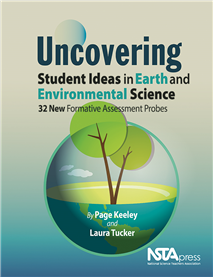Uncover Your Students’ Ideas in Earth and Environmental Science
By Carole Hayward
Posted on 2016-04-22
 The newest book in the NSTA Press best-selling Uncovering Student Ideas in Science series is here!
The newest book in the NSTA Press best-selling Uncovering Student Ideas in Science series is here!
Uncovering Student Ideas in Earth and Environmental Science by Page Keeley and Laura Tucker offers 32 formative assessment probes to get your students digging deep into environmental science concepts.
Find out what your students think and what they misunderstand with these fun and thought-provoking probes.
This is the 10th book in the Uncovering Student Ideas series, and the first one that targets environmental science. Like the other books, this one is designed to help reveal places where students are getting lost.
The book will help to “uncover preconceptions students bring to their learning, as well as identify misunderstandings students develop during instruction that may go unnoticed by teachers,” Keeley and Tucker write.
How do the probes do this? Each probe includes ideas, myths, or bad information that students might believe and one carefully-researched correct answer. Through the process of working through each probe, students will work through any misconceptions they might have.
Intended for students in grades 3–12, the book covers land, water, weather, climate, Earth history, erosion, plate tectonics, natural resources, pollution, and human impact.
In the book’s first lesson, “What’s Beneath Us?” five friends dig in the garden and ponder what the Earth would be like 10 miles below them. Each friend posits a theory of what they would find if they keep digging.
What is down there? Solid rock with a very thin layer of soil on top? Mostly big rocks, small stones, and gravel with a layer of soil on top? Mostly soil with scattered rocks? Big rocks with a little soil on top and in-between? Repeating layers of soil and rock?
The student is asked to decide which of the five gardeners has the best idea. In the teachers’ notes are tips for administering the probe and suggestions for instruction and assessment. These classroom-tested probes relate to core ideas from the American Association for the Advancement of Science’s Benchmarks for Science Literacy and the National Research Council’s A Framework for K–12 Science Education.
The tools are easy to use and effective for instruction. Give one a try. Check out this free chapter, “Groundwater“.
This book is also available as an e-book.
Follow NSTA
Disclaimer: The views expressed in this blog post are those of the author(s) and do not necessarily reflect the official position of the National Science Teaching Association (NSTA).


